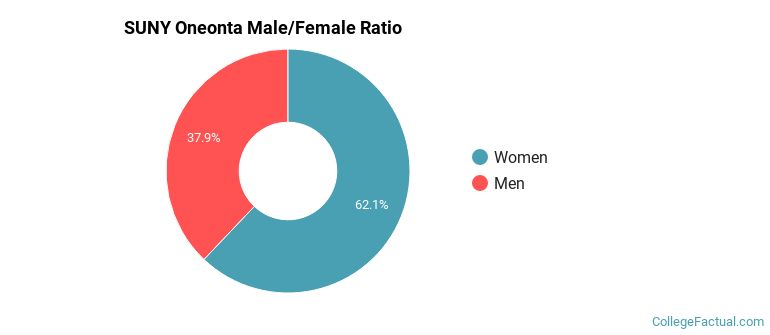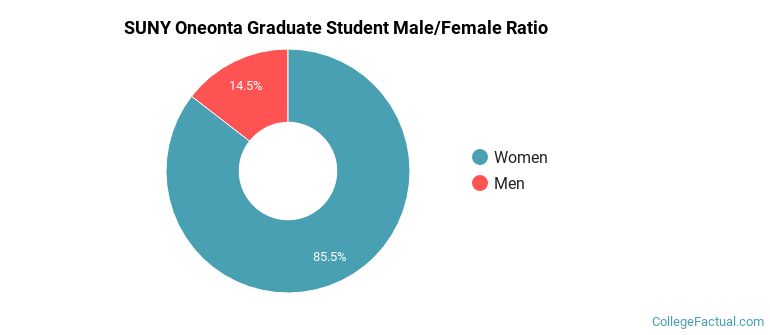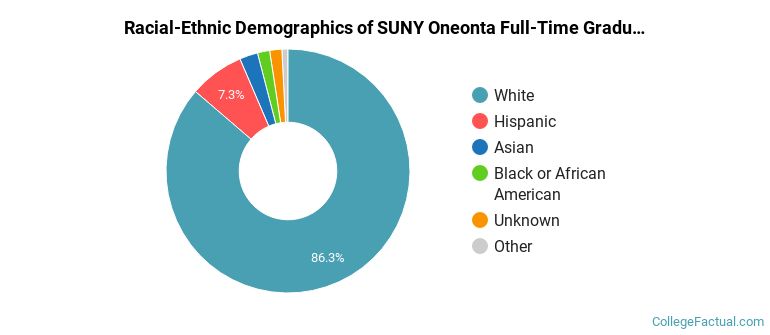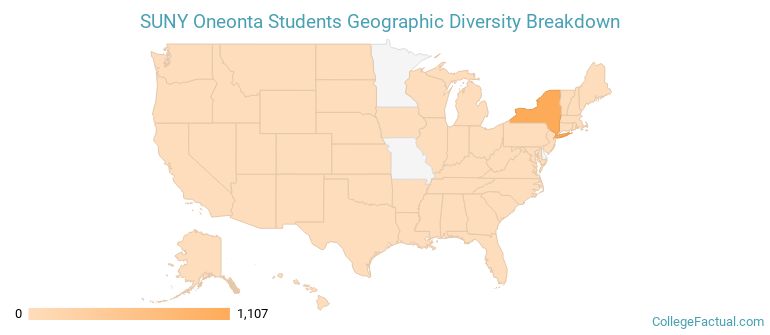 by our College Data Analytics Team
by our College Data Analytics TeamSUNY Oneonta total enrollment is approximately 6,718 students. 6,059 are undergraduates and 149 are graduate students.
Male/Female Breakdown of Undergraduates
The full-time SUNY Oneonta undergraduate population is made up of 63% women, and 37% men.

For the gender breakdown for all students, go here.
SUNY Oneonta Racial/Ethnic Breakdown of Undergraduates

| Race/Ethnicity | Number |
|---|---|
| White | 4,222 |
| Hispanic | 960 |
| Black or African American | 313 |
| Unknown | 236 |
| Multi-Ethnic | 137 |
| Asian | 129 |
| International | 19 |
| Native Hawaiian or Pacific Islander | 2 |
See racial/ethnic breakdown for all students.
Male/Female Breakdown of Graduate Students
About 81% of full-time grad students are women, and 19% men.

For the gender breakdown for all students, go here.
SUNY Oneonta Racial-Ethnic Breakdown of Graduate Students

| Race/Ethnicity | Number |
|---|---|
| White | 134 |
| Hispanic | 5 |
| Asian | 4 |
| Black or African American | 2 |
| Multi-Ethnic | 2 |
| Unknown | 2 |
| Native Hawaiian or Pacific Islander | 0 |
| International | 0 |
See racial/ethnic breakdown for all students.

| Race/Ethnicity | Number |
|---|---|
| White | 4,784 |
| Hispanic | 1,011 |
| Black or African American | 328 |
| Unknown | 248 |
| Multi-Ethnic | 141 |
| Asian | 138 |
| International | 21 |
| Native Hawaiian or Pacific Islander | 4 |

There are approximately 4,311 female students and 2,407 male students at SUNY Oneonta.
SUNY Oneonta ranks 1,901 out of 2,183 when it comes to geographic diversity.
0.98% of SUNY Oneonta students come from out of state, and 0.27% come from out of the country.

The undergraduate student body is split among 7 states (may include Washington D.C.). Click on the map for more detail.

| State | Amount |
|---|---|
| New York | 1,107 |
| New Jersey | 4 |
| Connecticut | 2 |
| Pennsylvania | 2 |
| Florida | 1 |
Learn more about international students at SUNY Oneonta.
A traditional college student is defined as being between the ages of 18-21. At SUNY Oneonta, 79.08% of students fall into that category, compared to the national average of 60%.

| Student Age Group | Amount |
|---|---|
| 20-21 | 2,622 |
| 18-19 | 2,406 |
| 22-24 | 964 |
| 25-29 | 240 |
| 35 and over | 65 |
| 30-34 | 45 |
| Under 18 | 0 |
Footnotes
*The racial-ethnic minorities count is calculated by taking the total number of students and subtracting white students, international students, and students whose race/ethnicity was unknown. This number is then divided by the total number of students at the school to obtain the racial-ethnic minorities percentage.
References
Department of Homeland Security Citizenship and Immigration Services
Image Credit: By Roy Saplin under License
Find out how College Factual created their Diversity Rankings.